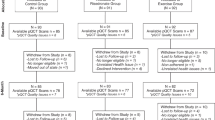Abstract
Summary
Scanner mismatch occurs frequently with follow-up dual-energy x-ray absorptiometry (DXA) scans. Nearly one-in-five follow-up DXA scans were conducted on non-cross-calibrated scanners (scanner mismatch) and more than a quarter of patients who had a follow-up DXA scan had experienced scanner mismatch.
Introduction
Detecting significant changes in bone mineral density (BMD) with dual-energy x-ray absorptiometry (DXA) scanners relies on the least significant change (LSC). Results from two different DXA scanners can only be compared, albeit with decreased sensitivity for change, if the LSC between the two scanners has been directly determined through cross-calibration. Performing follow-up DXA scans on non-cross-calibrated scanners (scanner mismatch) has safety and economic implications. This study aims to determine the proportion of scanner mismatch occurring at a population level.
Methods
All patients who completed at least two DXA scans between 1 April 2009 and 31 December 2018 in the province of Alberta, Canada, were identified using population-based health services databases. Scanner mismatch was defined as a follow-up DXA scan completed on a DXA scanner that differed from and was not cross-calibrated to the previous DXA scanner. Multivariate logistic regression models were used to assess predictive factors that may contribute to scanner mismatch.
Results
A total of 264,866 patients with 470,641 follow-up DXA scans were identified. Scanner mismatch occurred in 18.9% of follow-up DXA scans; 28.7% of patients experienced at least one scanner mismatch. Longer duration between scans (OR 1.25, 95% CI 1.24–1.26) and major osteoporotic fracture history before index scan (OR 1.06, 95% CI 1.03–1.08) increased risk of scanner mismatch. Osteoporosis medication use before index scan (OR 0.89; 95% CI 0.88–0.91), recency of follow-up scans (OR 0.98, 95% CI 0.73–0.98), female sex (OR 0.97, 95% CI 0.94–1.00), and age at last scan (OR 0.99, 95% CI 0.99–1.00) were associated with lower risk of scanner mismatch.
Conclusion
Scanner mismatch is a common problem, occurring in one-in-five follow-up DXA scans and affecting more than a quarter of patients. Interventions to reduce this large proportion of scanner mismatch are necessary.

Similar content being viewed by others
Data Availability
Data may be available on request.
References
El Maghraoui A, Achemlal L, Bezza A (2006) Monitoring of dual-energy x-ray absorptiometry measurement in clinical practice. J Clin Densitom 9(3):281–286. https://doi.org/10.1016/j.jocd.2006.03.014
Messina C, Bandirali M, Sconfienza LM et al (2015) Prevalence and type of errors in dual-energy x-ray absorptiometry. Eur Radiol 25:1504–1511. https://doi.org/10.1007/s00330-014-3509-y
Shepherd JA, Morgan SL, Lu Y (2008) Comparing BMD results between two similar DXA systems using the generalized least significant change. J Clin Densitom 11(2):237–242. https://doi.org/10.1016/j.jocd.2008.02.001
Dowthwaite JN, Dunsmore KA, Wang D et al (2018) Cross-calibrated dual-energy x-ray absorptiometry scanners demonstrate systematic bias in pediatric and young adult females. J Clin Densitom 21(2):281–294. https://doi.org/10.1016/j.jocd.2017.01.007
Jankowski LG, Warner S, Gaither K et al (2019) Cross-calibration, least significant change and quality assurance in multiple dual-energy x-ray absorptiometry scanner environments: 2019 ISCD Official Position. J Clin Densitom 22(4):472–483. https://doi.org/10.1016/j.jocd.2019.09.001
Alberta Medical Association (2020) Fee navigator: health service code X128. Alberta Medical Association. https://www.albertadoctors.org/fee-navigator/hsc/X128. Accessed 2020 Sep 9
Statistics Canada (2020) Table 17–10–0005–01 population estimates on July 1st, by age and sex. Statistics Canada. https://www150.statcan.gc.ca/t1/tbl1/en/tv.action?pid=1710000501. Accessed 2020 Sep 23
Public Health Agency of Canada (2010) What is the impact of osteoporosis in Canada and what are Canadians doing to maintain healthy bones? Public Health Agency of Canada. https://www.canada.ca/content/dam/phac-aspc/migration/phac-aspc/cd-mc/osteoporosis-osteoporose/pdf/osteoporosis.pdf. Accessed 2020 Sep 27
Alberta Government (2015) Population distribution, Alberta economic regions. Alberta Government. https://open.alberta.ca/opendata/population-distribution-alberta-economic-regions. Accessed 2020 Sep 27
Government of Canada (2019) Canada's health care system. Government of Canada. https://www.canada.ca/en/health-canada/services/health-care-system/reports-publications/health-care-system/canada.html. Accessed 2021 Mar 20
Siminoski K, O’Keeffe M, Levesque J et al (2011) Canadian Association of Radiologists technical standards for bone mineral densitometry reporting. Can Assoc Radiol J 62:166–175
Siminoski K, O’Keeffe M, Brown JP et al (2013) Canadian Association of Radiologists technical standards for bone mineral densitometry reporting. Can Assoc Radiol J 64(4):281–294
Leslie W, Schousboe J, Morin S et al (2020) Fracture risk following traumatic versus non-traumatic fracture: a registry-based cohort study. Osteoporosis Int 31(6):1059–1067. https://doi.org/10.1007/s00198-019-05274-2
Brodersen J, Siersma VD (2013) Long-term psychosocial consequences of false-positive screening mammography. Ann Fam Med 11(2):106–115. https://doi.org/10.1370/afm.1466
Kwon C, Farrell PM (2000) The magnitude and challenge of false-positive newborn screening test results. Arch Pediatr Adolesc Med 154(7):714–718. https://doi.org/10.1001/archpedi.154.7.714
Tluczek A, Orland KM, Cavanagh L (2011) Psychosocial consequences of false-positive newborn screens for cystic fibrosis. Qual Health Res 21(2):174–186. https://doi.org/10.1177/1049732310382919
Ioannidis G, Papaioannou A, Hopman WM et al (2009) Relation between fractures and mortality: results from the Canadian Multicentre Osteoporosis Study. Can Med Assoc J 181(5):265–271. https://doi.org/10.1503/cmaj.081720
Author information
Authors and Affiliations
Contributions
Study concept and design: CY, KA. Data acquisition: KA, ML. Statistical analysis: ML. Main drafting and editing of paper: KL, KS, CY. All authors critically reviewed, revised, and approved the final manuscript for publication.
Corresponding author
Ethics declarations
Ethics approval
Ethics approval was granted by the ethics board at the University of Alberta (Pro00088759). Waiver of individual consent was also granted as we analyzed de-identified data from numerous patients.
Consent to participate
Not applicable.
Consent for publication
Not applicable.
Conflicts of interest
None.
Additional information
Publisher's Note
Springer Nature remains neutral with regard to jurisdictional claims in published maps and institutional affiliations.
Rights and permissions
About this article
Cite this article
Lee, K., Al Jumaily, K., Lin, M. et al. Dual-energy x-ray absorptiometry scanner mismatch in follow-up bone mineral density testing. Osteoporos Int 33, 1981–1988 (2022). https://doi.org/10.1007/s00198-022-06438-3
Received:
Accepted:
Published:
Issue Date:
DOI: https://doi.org/10.1007/s00198-022-06438-3




